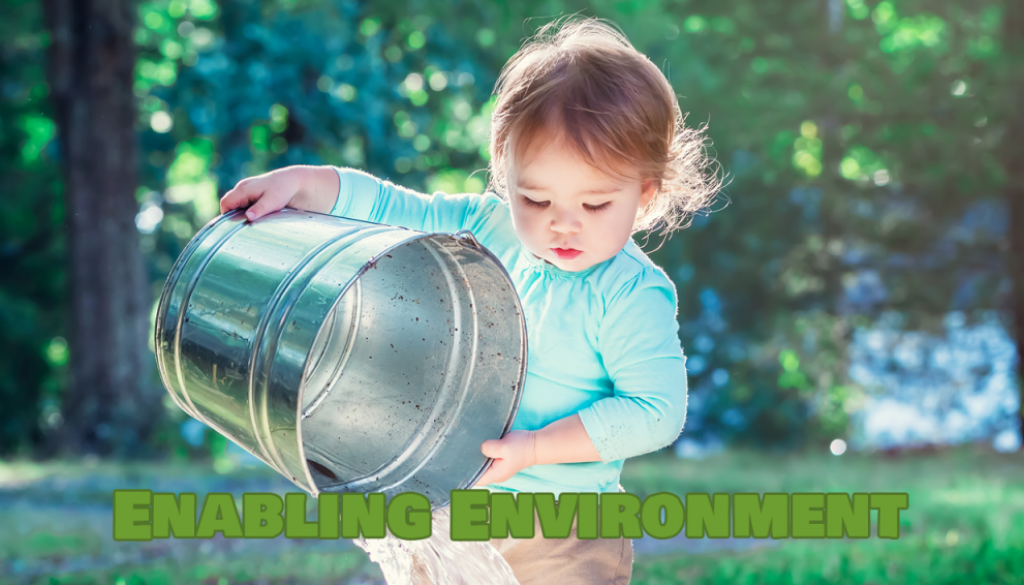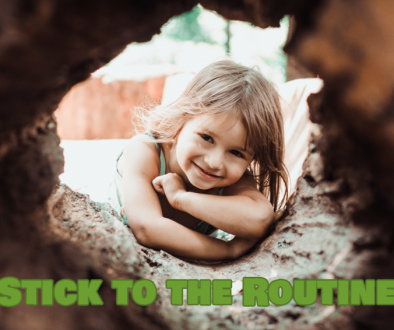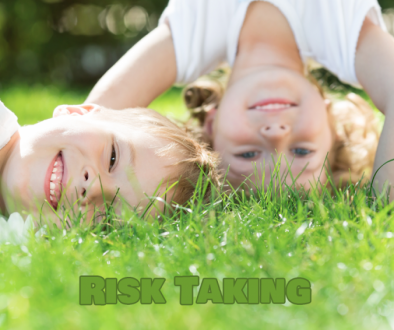Surviving Lockdown #1
Enabling Environment
To watch the accompanying information video go here
It is widely known in the early years sector that in order for young children to develop and learn they need to spend a lot of time engaged in Child-led activities.
Child-led activities are when a child is left to do what they choose, exploring, discovering, growing and developing through enjoyment.
It is also known that we can encourage meaningful child-led activity by creating an Enabling Environment.
An Enabling Environment will encourage children to motivate themselves and do things independently. It will allow a child to develop naturally through exploring, moving and experimenting.
Of course, it is really important for parents to spend a lot of time with their children but we all need time apart. Here are some ideas of how to create an enabling environment at your home and why this will be good for both your child and you.
Enabling environments can be split into three areas:
• The Emotional Environment how the environment feels and how it makes them feel
• The Indoor Environment how the different areas of your home are set up to encourage independent and self-motivated play and exploration
• The Outdoor Environment how the different areas of your garden are set up to encourage independent and self-motivated play and exploration. If you do not have a garden, how you will maximise time outdoors.
The Emotional Environment
Young children require an environment where:
• they feel safe and secure
• they feel happy
• they feel that those around them are happy (this will be discussed more in the emotional wellbeing article)
• they know that their parents are nearby if they need them
• they learn how to express and talk about their feelings
• they are involved in making the ground rules for behaviour, allowing them ownership of what is expected of them (and you)
The Physical Environment
Young children require an environment (inside and outside) that:
• is safe
• provides them with space to move
• is organised and has clear areas
• offers many opportunities to learn and explore
• provides toys and activities that can be used in many different ways, e.g. a box
• gives them spaces for quiet and reflection time, especially if they have siblings
• inspire imagination and role play
• explores personal relationships and feelings
• provides opportunity for problem solving
• Create different areas in your home, i.e. reading corner, activity area, dining area, construction area, art area, carpet play, IT area, etc.
• Ensure activities and resources are at child height and accessible and use resources which can be moved and used in a variety of ways
• Engage children in activities to build their emotional resilience and social skills
Indoor
Keep it Simple
• If you have space, place some of your child’s toys in a storage area to give them less options to choose from.
• Rotate options of toys and activities when your child appears to be bored of the options they have.
• Allow your child to choose from the small selection of toys / activities from a specific place that is accessible and at their level
• Teach them to pack their toys away when they are finished with them
• Stick to the plan – with repetition and reinforcement children quickly learn what is expected of them
Be Organised
• Create a place for everything
• Place things at a child-friendly level
• Ensure children know where everything is, encouraging independence
• Give them simple challenges and tasks
• Avoid distractions and distracting (don’t feel guilty for leaving them to get on with the task at hand)
• Keep to a plan / schedule
• Teach children to value their space
Ensure there are spaces inside where children can be active!
If space is limited, consider activities such as:
• Dancing
• Active stories
• Yoga.
These do not require a lot of space, yet significantly raise the heart rate.
The Bedroom Area
Unclutter the bedroom area and as mentioned above, place some of their toys in a storage space and work with your child to organise the toys that are left into baskets, shelves, etc. that they can easily reach.
Including your child in sorting their belongings will create ownership of the space and they will value it more.
Like their toys, if you can store away some of your child’s clothing and place the rest of their clothes in accessible places and at accessible heights, you can then encourage them to choose what they want to wear and, if old enough, dress themselves. Dressing is a skill that children need to learn and the sooner you allow them to practice the the sooner they will develop the ability to do so.
What better time than now, when your child is stuck in the house a lot, to let them dress themselves. No one has to see them in the weird and wonderful outfit choices!
At the end of the day, teach your child to put their clothes away, i.e. in the wash basket, etc.
Keep technology out of the bedroom, this should be a lovely calm space, used for sleeping, reading (could be the “book corner”), dressing and some calm play.
The Lounge / Spare Area
The Lounge could be the area where children use technology and do physical activities.
If you have more than one lounging area, or can clear out a spare room, allocate one toom as the physical activity room and the other as the relaxing room. The IT area can be in either.
The Kitchen
Getting children involved in the kitchen is a great way to help them develop their independence and fine motor skills.
Give children tasks, such as fetching various items that are placed at their height, putting items back once they have been used, prepare food, clean surfaces, and wash dishes.
Provide them with a stool to stand on to allow them to reach.
Create some simple regular weekly dishes so that your child can independently prepare them:
• Fruit kebabs
• Baking biscuits
• Scrambled eggs
After some modelling and support you will be surprised what a 3-year-old can do by themselves!
The Dining Area
More than ever, it is very important to create good habits around eating and family time.
Eating together at the table is a great way for families to connect, add to a routine and have positive conversations and time together.
This time will reinforce your child’s sense of security and self-worth and you will be surprised how much it will help your sense of wellbeing too.
Outdoor
Children should be outdoors as much as possible and have a balance of child-led and adult-let activity time.
If you do not have an outdoor space, finding any form of nature will stimulate a child. When in the outdoors encourage your children to explore on their own terms, alternatively set them challenges to encourage them to learn to discover and explore.
Provide different areas
Divide the outdoor area into different sections. Examples:
• Messy play
• Wheeled equipment (bicycles, etc.)
• Bug hut (Collected logs and pieces of wood to look under)
• Physical area (open space, large equipment such as climbing frame, large tree trunks, trees, etc.)
• Quiet area (For children to relax, read, etc.)
• Role-play area
• Den
Inexpensive outdoor resource ideas
• Chalk to create games on cemented surfaces
• Strong cardboard packaging to create shelters
• Pieces of fabric/ old sheets to make tents and dens
• Water Play area – Guttering, Shallow trays, empty spray bottles, paint brushes, containers, etc. to create water play area
• Tyres
• Planks, logs and pieces of wood, you can make stepping stones, a trim trail, etc.
• Signs – create your own to make the outdoor area have purpose or just look cool
• Boxes and crates to build with
• Old CDs (hello 1990s) hanging at different levels
• Old pots and pans strung on a strong line between trees with spoons to play them
• Trellis – perfect for weaving thread or vines through
• Old wellingtons to plant in
• Spare hosepipe wound along the fence with a funnel at each end to use as a telephone
• Plastic drinks bottle filled with different substances and objects to hang or to create skittles
Rotate resources to ensure children try a variety of things, allowing them to develop different skills.
Set up activities and leave children to continue without you and for them to create their own activities.
Observe and Amend
When you can, observe your child without disturbing them when they are engaged in play or an activity and identify if they:
• are engaged and enjoying themselves
• are doing as expected of them, i.e. completing a task, packing toys away, respecting the areas and what they are for
• are focussed and able to concentrate. The more you allow them the more children are able to develop their focus and concentration
If any of the above is not happening, make slight changes such as:
• amend the activity to reflect their interests or offer different toys
• make the task easier or different
• reinforce what is expected, i.e. they need to pack away toys when finished playing with them
• change where toys and resources are placed to make them easier to access
• clarify what each area in your house is used for and how we look after the areas
• if they aren’t able to focus perhaps use their interests and imagination to make the activity more engaging, make it easier
• find ways to encourage the rest of the family to give each other space to focus and concentrate on their own tasks
Babies
Please see my previous Baby Physical Development and Tummy Time films.
Some Top Tips:
• Regularly place babies on their front, back and side
• Before babies become mobile, allow plenty of tummy time, little and often
• Provide soft areas inside and outside to place babies on
• It is important for babies to spend lots of time outside
• Ensure clothing does not restrict movement, soft flexible fabric and no shoes are best
• Reduce long periods of stillness
• Use age-appropriate sensory stimulation
• Place stimulating objects just out of reach to encourage movement
• When babies become mobile, ensure they have space to move about in and provide stimulating objects to encourage movement and make it more fun.
Remember: if adults are moving and enjoying themselves then babies and young children will be more likely to join it. Keep moving!




